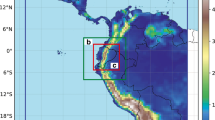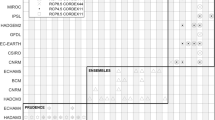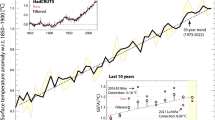Abstract
Changes in temperature, precipitation, and other variables simulated by 40 current climate models for the 21st century are approximated as the product of the global mean warming and a spatial pattern of scaled changes. These fields of standardized change contain consistent features of simulated change, such as larger warming over land and increased high-latitude precipitation. However, they also differ across the ensemble, with standard deviations exceeding 0.2 for temperature over most continents, and 6% per degree for tropical precipitation. These variations are found to correlate, often strongly, with indices based on those of modes of interannual variability. Annular mode indices correlate, across the 40 models, with regional pressure changes and seasonal rainfall changes, particularly in South America and Europe. Equatorial ocean warming rates link to widespread anomalies, similarly to ENSO. A Pacific–Indian Dipole (PID) index representing the gradient in warming across the maritime continent is correlated with Australian rainfall with coefficient r of − 0.8. The component of equatorial warming orthogonal to this index, denoted EQN, has strong links to temperature and rainfall in Africa and the Americas. It is proposed that these indices and their associated patterns might be termed “modes of climate change”. This is supported by an analysis of empirical orthogonal functions for the ensemble of standardized fields. Can such indices be used to help constrain projections? The relative similarity of the PID and EQN values of change, from models that have more skilful simulation of the present climate tropical pressure fields, provides a basis for this.












Similar content being viewed by others
References
Abramowitz G (2010) Model independence in multi-model ensemble prediction. Aust Meteorol Oceanogr J 59:3–6
Annan JD, Hargreaves JC (2010) Reliability of the CMIP3 ensemble. Geophys Res Lett 37:L02703. https://doi.org/10.1029/2009GL041994
Arblaster JM, Meehl GA, Moore AM (2002) Interdecadal modulation of Australian rainfall. Clim Dyn 18:519–531. https://doi.org/10.1007/s00382-001-0191-y
Branstator G, Selten F (2009) Modes of variability and climate change. J Clim 22:2639–2658. https://doi.org/10.1175/2008JCLI2517.1
Brown JR, Moise AF, Colman R, Zhang H (2016) Will a warmer world mean a wetter or drier Australian monsoon? J Clim 29:4577–4596. https://doi.org/10.1175/JCLI-D-15-0695.1
Christensen JH, Krishna Kumar K, Aldrian E, An SI, Cavalcanti IFA, de Castro M, Dong W, Goswami P, Hall A, Kanyanga JK, Kitoh A, Kossin J, Lau NC, Renwick J, Stephenson DB, Xie SP, Zhou T (2013) Climate phenomena and their relevance for future regional climate change. In: Stocker TF, Qin D, Plattner GK, Tignor M, Allen SK, Boschund J, Nauels A, Xia Y, Bex V, Midgley PM (eds) Climate change 2013. The physical science basis. Cambridge University Press, Cambridge, pp 1217–1308
Collins M, The CMIP Modelling Groups (2005) El Niño or La Niña-like climate change. Clim Dyn 24:89–104. https://doi.org/10.10007/S00382-004-0478-x
Collins M, Knutti R, Arblaster J, Dufresne JL, Fichefet T, Friedlingstein P, Gao X, Gutowski WJ, Johns T, Krinner G, Shongwe M, Tebaldi C, Weaver AJ, Wehner M (2013) Long-term climate change: projections, commitments and irreversibility. In: Stocker TF, Qin D, Plattner GK, Tignor M, Allen SK, Boschund J, Nauels A, Xia Y, Bex V, Midgley PM (eds) Climate change 2013. The physical science basis. Cambridge University Press, Cambridge, pp 1029–1136
CSIRO, Bureau of Meteorology (2015) Climate change in Australia Information for Australia’s Natural Resource Management Regions. http://www.climatechangeinaustralia.gov.au. Technical report, CSIRO and Bureau of Meteorology, Australia
Deser C, Phillips A, Bourdette V, Teng H (2012) Uncertainty in climate change projections: the role of internal variability. Clim Dyn 38:527–546
Dommenget D, Latif M (2008) Generation of hyper climate modes. Geophys Res Lett 35:L02706. https://doi.org/10.1029/2007GL031087
Flato G, Marotzke J, Abiodun B, Braconnot P, Chou SC, Collins W, Cox P, Driouech F, Emori S, Eyring V, Forest C, Gleckler P, Guilyardi E, Jakob C, Kattsov V, Reason C, Rummukainen M (2013) Evaluation of climate models. In: Stocker TF, Qin D, Plattner GK, Tignor M, Allen SK, Boschund J, Nauels A, Xia Y, Bex V, Midgley PM (eds) Climate change 2013. The physical science basis. Cambridge University Press, Cambridge, pp 741–866
Gillett NP, Fyfe JC (2013) Annular mode changes in the CMIP5 simulations. Geophys Res Lett 40:1189–1193. https://doi.org/10.1002/grl.50249
Gillett NP, Kell TD, Jones PD (2006) Regional climate impacts of the southern annular mode. Geophys Res Lett 33:L23704. https://doi.org/10.1029/2006GL027721
Gong D, Wang S (1999) Definition of Antarctic oscillation index. Geophys Res Lett 26:459–462
Grise KM, Polvani LM (2014) Is climate sensitivity related to dynamical sensitivity? A Southern Hemisphere perspective. Geophys Res Lett 41:534–540. https://doi.org/10.1002/2013GL058466
Grose MR, Bhend J, Narsey S, Sen Gupta A, Brown JR (2014) Can we constrain CMIP5 rainfall projections in the tropical Pacific based on surface warming patterns? J Clim 27:9123–9138. https://doi.org/10.1175/JCLI-D-14-00190.s1
Hoell A, Funk C, Barlow M (2015) The forcing of southwest Asia teleconnections by low frequency sea surface temperature variability during boreal winter. J Clim 28:1511–1526
IPCC (2013) Summary for policymakers. In: Stocker TF, Qin D, Plattner GK, Tignor M, Allen SK, Boschund J, Nauels A, Xia Y, Bex V, Midgley PM (eds) Climate change 2013. The physical science basis. Cambridge University Press, Cambridge, pp 1–27
Karpechko AY (2010) Uncertainties in future climate attributable to uncertainties in future Northern Annular Mode trend. Geophys Res Lett 37(1–5):L20702. https://doi.org/10.1029/2010GL044717
Knutti R, Masson D, Gettelman A (2013) Climate model genealogy: generation CMIP5 and how we got there. Geophys Res Lett 40:1194–1199
Lee JY, Wang B, Seo KH, Kug JS, Choi YS, Kosaka Y, Ha KJ (2014) Future change of Northern Hemisphere summer tropical-extratropical teleconnection in CMIP5 models. J Clim 27:3643–3664
Li J, Wang JXL (2003) A modified zonal index and its physical sense. Geophys Res Lett 30:1632. https://doi.org/10.1029/2003GL017441
Marshall GJ (2003) Trends in the southern annular mode from observations and reanalyses. J Clim 16:4134–4143
O’Neill BC, Kriegler E, Riahi K, Ebi KL, Hallegatte S, Carter TR, Mathur R, van Vuuren DP (2014) A new scenario framework for climate change research: the concept of shared socioeconomic pathways. Clim Change 122:387–400. https://doi.org/10.1007/s10584-013-0905-2
Parker D, Folland C, Scaife A, Knight J, Colman A, Baines P, Dong B (2007) Decadal to multidecadal variability and the climate change background. J Geophys Res 112:D18115. https://doi.org/10.1029/2007JD008411
Ring MJ, Plumb RA (2008) The response of a simplified GCM to axisymmetric forcings: applicability of the fluctuation-dissipation theorem. J Atmos Sci 65:3880–3898
Sen Gupta A, England MH (2006) Coupled ocean–atmosphere–ice response to variations in the southern annular mode. J Clim 19:4457–4486
Sherwood SC, Bony S, Dufresne JL (2014) Spread in model climate sensitivity traced to atmospheric convective mixing. Nature 505:37–42
Tebaldi C, Arblaster JM (2014) Pattern scaling: its strengths and limitations, and an update on the latest model simulations. Clim Change 122:459–471. https://doi.org/10.1007/s10584-013-1032-9
Tedeschi RG, Collins M (2016) The influence of ENSO on South American precipitation during austral summer and autumn in observations and models. Int J Climatol 36:618–635. https://doi.org/10.1002/joc.4371s
Watterson IG (2001) Zonal wind vacillation and its interaction with the ocean: implications for interannual variability and predictability. J Geophys Res 106:23965–23975
Watterson IG (2007) Southern ‘annular modes’ simulated by a climate model: patterns, mechanisms, and uses. J Atmos Sci 64:3113–3131
Watterson IG (2008) Calculation of probability density functions for temperature and precipitation change under global warming. J Geophys Res 113:D12106. https://doi.org/10.1029/2007JD009254
Watterson IG (2009) Components of rainfall and temperature anomalies and change associated with modes of the Southern Hemisphere. Int J Climatol 29:809–826. https://doi.org/10.1002/joc.1772
Watterson IG (2012) Understanding and partitioning future climates for Australian regions from CMIP3 using ocean warming indices. Clim Change 111:903–922. https://doi.org/10.1007/s10584-011-0166x
Watterson IG (2013) Climate change simulated by full and mixed-layer ocean versions of CSIRO Mk3.5 and Mk3.0: the Asia–Pacific region. Asia Pac J Atmos Sci 49:287–300. https://doi.org/10.1007/s13143-013-0028-8
Watterson IG (2015) Improved simulation of regional climate by global models with higher resolution: skill scores correlated with grid length. J Clim 28:5985–6000. https://doi.org/10.1175/JCLI-D-14-00702.1
Watterson IG, O’Farrell SP (2013) Climate change simulated by full and mixed-layer ocean versions of CSIRO Mk3.5 and Mk3.0: large-scale sensitivity. Asia Pacific J Atmos Sci 49:375–387. https://doi.org/10.1007/s13143-013-0035-9
Watterson IG, Whetton PH (2011) Distributions of decadal means of temperature and precipitation change under global warming. J Geophys Res 116:D07101. https://doi.org/10.1029/2010JD014502
Weller E, Cai W (2013) Realism of the Indian Ocean dipole in CMIP5 models: the implications for climate projections. J Clim 26:6649–6659. https://doi.org/10.1175/JCLI-D-12-00807.1
Acknowledgements
This work was supported by the Australian Government’s Regional Natural Resources Management Planning for Climate Change Fund. The author is grateful to the modelling groups, PCMDI, and others who established the CMIP5 archive, and to colleagues who provided the global means and trend data used, in particular Louise Wilson and Tim Erwin, and Penny Whetton for support and advice over many years. Comments from two reviewers led to major improvements in the presentation, including the analysis of statistical significance in Sect. 6.
Author information
Authors and Affiliations
Corresponding author
Rights and permissions
About this article
Cite this article
Watterson, I.G. Indices of climate change based on patterns from CMIP5 models, and the range of projections. Clim Dyn 52, 2451–2466 (2019). https://doi.org/10.1007/s00382-018-4260-x
Received:
Accepted:
Published:
Issue Date:
DOI: https://doi.org/10.1007/s00382-018-4260-x




